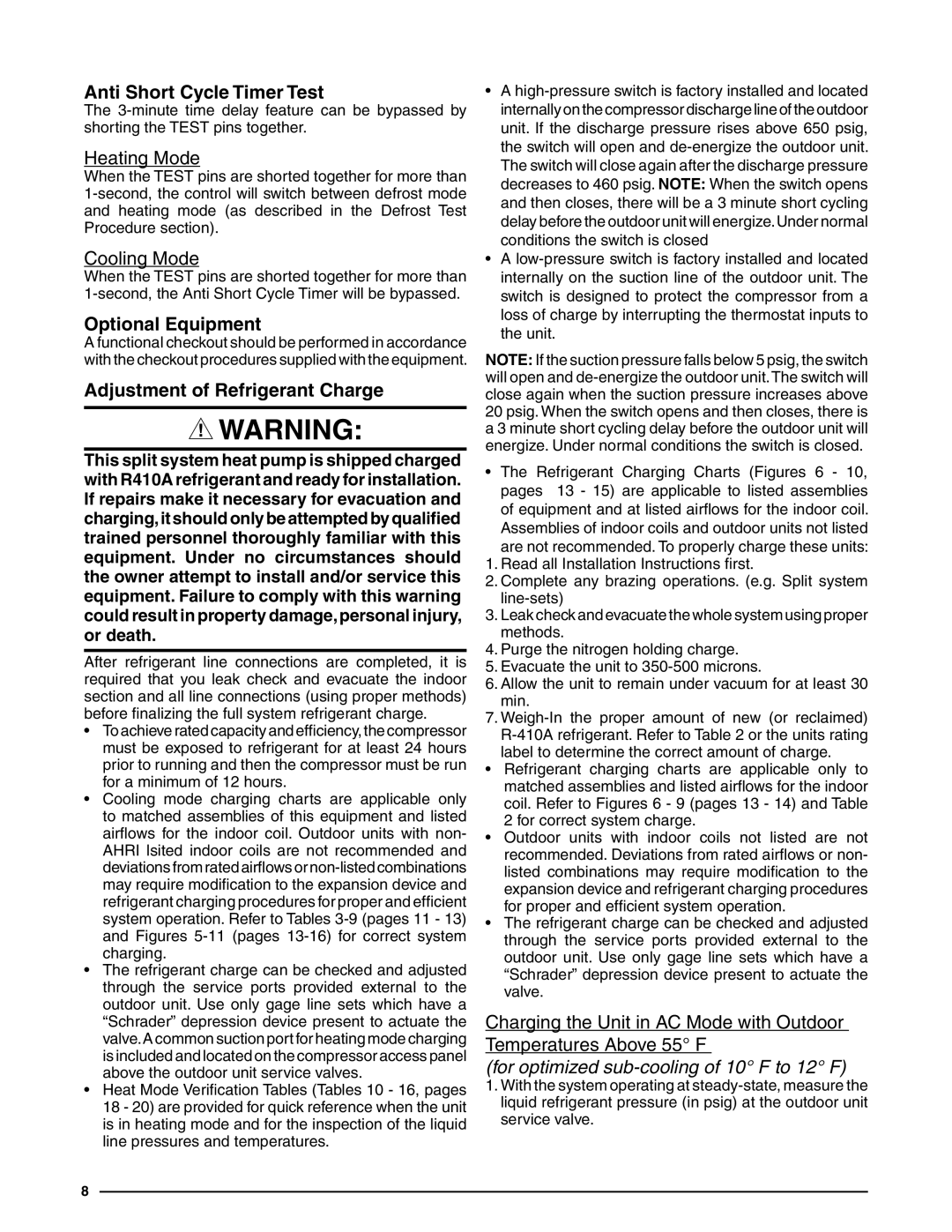Anti Short Cycle Timer Test
The 3-minute time delay feature can be bypassed by shorting the TEST pins together.
Heating Mode
When the TEST pins are shorted together for more than 1-second, the control will switch between defrost mode and heating mode (as described in the Defrost Test Procedure section).
Cooling Mode
When the TEST pins are shorted together for more than 1-second, the Anti Short Cycle Timer will be bypassed.
Optional Equipment
A functional checkout should be performed in accordance with the checkout procedures supplied with the equipment.
Adjustment of Refrigerant Charge
 WARNING:
WARNING:
This split system heat pump is shipped charged with R410A refrigerant and ready for installation. If repairs make it necessary for evacuation and charging,it should only be attempted by qualified trained personnel thoroughly familiar with this equipment. Under no circumstances should the owner attempt to install and/or service this equipment. Failure to comply with this warning could result in property damage,personal injury, or death.
After refrigerant line connections are completed, it is required that you leak check and evacuate the indoor section and all line connections (using proper methods) before finalizing the full system refrigerant charge.
•To achieve rated capacity and efficiency, the compressor must be exposed to refrigerant for at least 24 hours prior to running and then the compressor must be run for a minimum of 12 hours.
•Cooling mode charging charts are applicable only to matched assemblies of this equipment and listed airflows for the indoor coil. Outdoor units with non- AHRI lsited indoor coils are not recommended and deviations from rated airflows or non-listed combinations may require modification to the expansion device and refrigerant charging procedures for proper and efficient system operation. Refer to Tables 3-9 (pages 11 - 13) and Figures 5-11 (pages 13-16) for correct system charging.
•The refrigerant charge can be checked and adjusted through the service ports provided external to the outdoor unit. Use only gage line sets which have a “Schrader” depression device present to actuate the valve.A common suction port for heating mode charging is included and located on the compressor access panel above the outdoor unit service valves.
•Heat Mode Verification Tables (Tables 10 - 16, pages
18 - 20) are provided for quick reference when the unit is in heating mode and for the inspection of the liquid line pressures and temperatures.
•A high-pressure switch is factory installed and located internally on the compressor discharge line of the outdoor unit. If the discharge pressure rises above 650 psig, the switch will open and de-energize the outdoor unit.
The switch will close again after the discharge pressure decreases to 460 psig. NOTE: When the switch opens and then closes, there will be a 3 minute short cycling delay before the outdoor unit will energize.Under normal conditions the switch is closed
•A low-pressure switch is factory installed and located internally on the suction line of the outdoor unit. The switch is designed to protect the compressor from a loss of charge by interrupting the thermostat inputs to the unit.
NOTE: If the suction pressure falls below 5 psig, the switch will open and de-energize the outdoor unit.The switch will close again when the suction pressure increases above 20 psig. When the switch opens and then closes, there is a 3 minute short cycling delay before the outdoor unit will energize. Under normal conditions the switch is closed.
•The Refrigerant Charging Charts (Figures 6 - 10, pages 13 - 15) are applicable to listed assemblies of equipment and at listed airflows for the indoor coil. Assemblies of indoor coils and outdoor units not listed
are not recommended. To properly charge these units:
1.Read all Installation Instructions first.
2.Complete any brazing operations. (e.g. Split system line-sets)
3.Leak check and evacuate the whole system using proper methods.
4.Purge the nitrogen holding charge.
5.Evacuate the unit to 350-500 microns.
6.Allow the unit to remain under vacuum for at least 30 min.
7.Weigh-In the proper amount of new (or reclaimed) R-410A refrigerant. Refer to Table 2 or the units rating label to determine the correct amount of charge.
•Refrigerant charging charts are applicable only to matched assemblies and listed airflows for the indoor coil. Refer to Figures 6 - 9 (pages 13 - 14) and Table 2 for correct system charge.
•Outdoor units with indoor coils not listed are not recommended. Deviations from rated airflows or non- listed combinations may require modification to the expansion device and refrigerant charging procedures for proper and efficient system operation.
•The refrigerant charge can be checked and adjusted through the service ports provided external to the outdoor unit. Use only gage line sets which have a “Schrader” depression device present to actuate the valve.
Charging the Unit in AC Mode with Outdoor Temperatures Above 55° F
(for optimized sub-cooling of 10° F to 12° F)
1.With the system operating at steady-state, measure the liquid refrigerant pressure (in psig) at the outdoor unit service valve.

